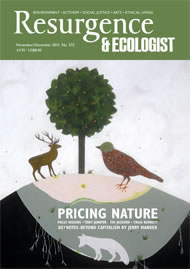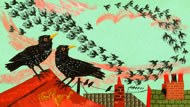It is fashionable nowadays to regard the countryside as under threat, and for very good reason. Populations of many of our most familiar birds and butterflies are in freefall, intensive farming has turned much of lowland Britain into a wildlife-free zone, and the onward march of development – the inexorable urge to build new railway lines, roads and runways – threatens the little that is left.
Ironically, Nature is taking refuge in towns and cities, which are now home to a far wider range of wild creatures than most rural areas. Britain’s cities play host to everything from orchids to otters, water voles to deer, and even the peregrine – the fastest living creature on the planet. Many once-rural creatures, including a wide range of woodland and hedgerow birds, are now more common in urban gardens than in the surrounding countryside.
Another productive suite of habitats is neither town nor country. These are the ‘messy bits’ of marginal land: roadside verges, gravel pits and railway cuttings, for example. They are treasure troves of diversity, oases for a range of plants and animals that have fled the farmed landscape in search of food, shelter and places to breed.
If you wanted to show a visitor to these shores a wide range of wildlife, you could do a lot worse than take them for a walk through what Richard Mabey once memorably dubbed “the unofficial countryside”.
Certainly you are more likely to see marbled white butterflies, goldfinches and cowslips along the verges of a trunk road than in an arable field, kingfishers are commoner along urban canals than on many rural rivers, and hedgehogs are more likely to be found in gardens than on farms.
That is not to say that the countryside is completely devoid of life. But to see a rich diversity of wildlife in rural Britain you usually have to visit a nature reserve: a tiny island of habitat preserved as a bulwark against the encroaching tide of bright green, ‘improved’ grassland.
It would be easy to blame the nation’s farmers for this state of affairs, and some do have a case to answer. But we must all share the blame: consumers who demand cheaper food at any cost; successive governments, of all political colours, which seem to regard wildlife as a bolt-on extra; and apathetic city-dwellers who accept the countryside lobby’s warped logic that only people who actually live in rural Britain should be allowed a say over its future.
There is another group that has also been at fault: conservationists. In the space of a couple of generations we have allowed a loose coalition of landowners, governments and big business to ride roughshod over any attempts to include wildlife as a central part of what makes the countryside special. If we did raise our voices in protest, we were accused of standing in the way of progress.
So are the voices raised in defence of rural Britain being raised in vain? And is there any countryside left worth preserving, or should we just call it a day?
I believe passionately not just that the countryside is worth saving, but that we need to reclaim it – for both Nature and people.
The first thing we need is a change in attitude from the small minority of people who have shouted loudest about the need to safeguard our rural heritage, while at the same time destroying it. They must accept that the countryside is not the preserve of any one special interest group, be they farmers or foxhunters, gamekeepers or grouse-shooters. It also belongs to the rest of the population, many of whom live in towns and cities and either visit the countryside for recreation and inspiration or would like to do so.
The next step is to stop compartmentalising the countryside into ‘villages’, ‘farmland’ and ‘nature reserves’, and look at the landscape as a whole. That’s what is happening where I live on the Somerset Levels. Here, in the shadow of Glastonbury Tor, local farmers, residents, businesses and conservationists, led by the Somerset Wildlife Trust, are engaged in a Living Landscape project.
This imaginative scheme aims to improve the lot of everyone for whom the countryside matters: landowners, farmers, naturalists, tourists, conservationists and householders. It does so not by ignoring Nature, but by embracing it.
Of course we need to find a balance. Food must be produced, houses must be built, and various forms of recreation have their place. But for more than half a century we have ignored the one thing that, should it disappear, would render the countryside irrelevant: the wildlife.
Putting wildlife back at the centre of our policies towards the countryside is not a magic bullet that will solve all our problems, but it is a good start. It is the catalyst towards recreating a balanced landscape, serving all our needs.
For wildlife – and Nature as a whole – is the heart and soul of rural Britain. It has inspired generations of poets, musicians and artists, and countless millions of ordinary folk, who gain spiritual sustenance from birdsong in spring, the buzzing of insects in a wild-flower meadow on a summer’s day, or the sky-dancing of millions of starlings on a winter’s evening.
Now we must use the natural world to inspire us, to transform the British countryside into something fit for both people and wildlife, both now and for the future.
Illustration © 2012 Mark Hearld, from A FIRST BOOK OF NATURE by Nicola Davies, illustrated by Mark Hearld. Reproduced by permission of Walker Books Ltd www.walker.co.uk








